Marisa Holmes is an organizer and educator from Brooklyn, New York. Her book Organizing Occupy Wall Street (Palgrave, 2023) is part personal testimony, memoir and critical analysis of this epic social movement and its immediate aftermath. She also made a documentary with the OWS Media Working Group called All Day All Week – An Occupy Wall Street Story. The subtitle is an interesting one: This is Just Practice. Instead of grand vistas and theories, Holmes immediately jumps into “the nuts and bolts of holistic transformation based on horizontal change using autonomist, feminist approaches,” as series editor Anitra Nelson writes in her preface. Holmes dives deep into the New York practices. Organized in response to the 2008 global financial crisis, the Occupy mindset consciously refused to make demands and instead produced a long list of grievances. While one of the well-known organizers David Graeber published his monumental Debt, the First 5000 Years around the same time as the protests, OWS should not be reduced to a moralistic critique of global finance, symbolized by ‘Wall Street’. Graeber’s Occupy account is called The Democracy Project for a reason. What OWS today stood for were values such as consensus, equality and broad participation—aspects the Western democracy machines lack.
Over the years my Occupy Wall Street library has steadily grown. Most of these ‘movement teachings’ are dear to me, also because I was in the fortunate position to participate in the New York events for a few days, in mid-October 2011. There’s Judith Butler’s performative theory of the assembly (“I am already an alliance.”) And Micah White’s version of OWS as a political blueprint of a coming revolution. Then there’s Sitrin & Azzellini’s comparative study that also reports about 2011 movements in Greece, Spain, Argentina and Venezuela. Or take Yates McKee’s specific study of the role of contemporary arts. At the ideas level, Marisa Holmes’ account can be best compared to Mark Bray’s Translating Anarchy about the anarchism of Occupy Wall Street. What Holmes does best is taking the reader back to the actual events as unfold, how discussions played out and how alternative concepts steer and intervene in the historical unfolding of a movement.
Holmes’ chronology describes the dynamics of the ‘leaderless’ general assembly with its working groups, hand signals and mic checks. Holmes describes how leadership was feminized and stresses the role of the connector and the facilitation of meetings as a form of ‘empowering’ leadership. As Lisa Fithian explains: “Facilitators must be confident, be authentic, and work with integrity. They need to be aware of the energy of the group, group needs, and watch for body language cues.” In this light, we see the emergence of new figures such as the stack taker, minute taker and vibe watcher. In this email exchange, Marisa Holmes and I dug deeper into the ‘practices of organization’ of movements from the past decade. I left out the social media question and the larger alternative media uses, back in 2011, and now. Weeks after I returned from New York, our Institute of Network Cultures started the Unlike Us network on social media critique and their alternatives. The ‘tactical’ use of Facebook and Twitter at the time was rather naïve, to say the least. Strangely enough, that was not the focus at the time. This was, sadly, the start of a long decade of ‘unreconstructed’ use of corporate social media platforms by social movements, from metoo#, Black Lives Matter and Extinction Rebellion—up to today.
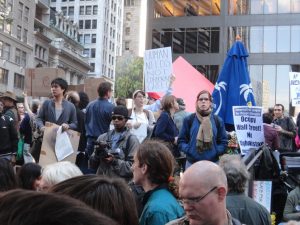
Geert Lovink: Retrospectively, what are the lessons learned from Occupy Wall Street for social movements today? It’s now 12 years ago. Time and again you emphasize more self-organization and I agree with that. How would you do it differently this time? Can you relate this to ’the forces that wanted to tear us down’? They seem to be so much more powerful. You mention institutionalization, co-optation, repression, and counter-revolution. In many countries, you mention the last.
Marisa Holmes: In 2011, there were occupations of squares across the globe from North Africa and the Middle East to Europe, and, finally, the United States. Despite very different local contexts, there were shared horizontal, participatory, and directly democratic aims, and practices. The occupation of the Kasbah in Tunis began after the departure of Ben Ali to continue the revolution. Thousands converged calling for an end to the transitional government and building of regional democratic assemblies in its place. Participants in the Kasbah created working groups for food, sanitation, security, and other tasks. This set the example for Tahrir in Cairo, Puerta del Sol in Madrid, Syntagma in Athens, and Zuccotti Park in New York City. In all these places assemblies were not undifferentiated masses, but aggregates of individuals, who participated in decision-making. Resources were distributed, and needs were met through mutual aid. Self-organization allowed people to realize their capacities, and act in solidarity rather than unity. We were successful because we created alternative ways of being together socially, culturally, and politically. Another world was possible and actually happening.
It is precisely because of our success that capitalists and politicians sought to undermine us. Funders attempted to neutralize our actions by creating hierarchies around access to resources. A culture of professionalization took hold, which advanced those who already had power and privilege, and intensified fissures within movements. Politicians redirected our rhetoric and communication channels toward party politics. These same politicians, once in power, collaborated with law enforcement at all levels, to criminalize us. Similar patterns played out across the squares. In Tunisia and Egypt, there were Islamic parties that took power (Ennahda and the Muslim Brotherhood) followed by secular opposition. All used the rhetoric of revolution while accelerating counterterrorism against revolutionaries. In Spain and Greece left political parties (Podemos and Syriza) claimed to be coming from movements but drifted from them once elected. In the United States, the Bernie Sanders campaign used the framing of 99% and 1% for a so-called political revolution while discrediting more radical elements.
The world now has been shaped by these movements, and the reactions to them. Co-optation and repression have distorted movements beyond recognition. This has created a vacuum for a counter-revolution, which channels popular anger against the establishment. These are dangerous times. We are living with the rise of neo-fascism and neo-liberal attempts to restore the status quo. I argue that neither will resolve the crisis (political, economic, and otherwise), and the only way forward is a true social revolution.
To achieve our aims, we need to return to what was successful about the 2011 movements and embrace self-organization. We must continue to assemble and practice democratic decision-making. We must coordinate with one another, at scale, and across borders. However, there must be more attention to accountability and equity. Our lack of accountability made It possible for harm and conflict to happen without consequences. Our lack of equity created invisible hierarchies and exacerbated divisions of race, gender, and class. These were weaknesses, but ones that we can learn from and overcome. If we had baked in accountability and equity from the beginning, then we would have not only been more prefigurative and true to our ideals, but also stronger against our enemies.
Another key lesson from 2011, is to control access and ownership of communication technology. Movements embraced both the creation of open-source alternatives and corporate platforms. Wikileaks and Anonymous popularized a culture of hacking and making tactical interventions. This influenced the media practices of the squares. At the same time, Facebook, Twitter, and YouTube, were used to gain access to larger audiences. As alternatives were targeted by the state, so were social media accounts, and their admins. Communication technology was essential to the creation and maintenance of the 2011 movements. It replaced more central, hierarchical modes of organization, and helped facilitate self-organization. The success of movements now and in the future, will depend on our ability to create and defend communication infrastructure.
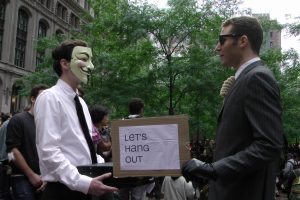
GL: Your book came out more than a decade after the events. Yet, it reads like it all happened yesterday. Retrospectively, what are the lessons learned of Occupy Wall Street for social movements today? How do you look at the organization models of #metoo, the 2020 wave of Black Lives Matter and Extinction Rebellion?
MH: Time has a funny way of bending. In 2011 It felt like whole years had passed in a day, and somehow It was all over too quickly. We were living in the “now time” as Walter Benjamin would say. It was a moment of rupture when all things seemed possible, and perhaps actually were. I’m someone who is constantly playing with time, as a filmmaker. I replay events long after they occur. The figures and actions continue to live with me like ghosts, so you might say I’m haunted.
I’d place the end of OWS, and the larger 2011 cycle, around the Fall of 2013. By then there had been many attempts to hold together a network under the OWS umbrella, as well as multiple “offshoots” such as Strike Debt and Occupy Sandy. The summer of 2013 was one last return to the square, with Gezi Park in Turkey and the Fare Hike movement in Brazil. By the end of the year, though, there was the Maidan movement in Ukraine, which took a markedly different turn. While OWS, and the larger cycle, ended, this doesn’t mean there weren’t lessons learned, and incorporated into future movements. There were.
Like OWS, BLM, MeToo, and XR, all have been characterized by horizontal, democratic forms of self-organization. In all cases, there’s been either a rejection of leadership or a re-imagining of leadership. While there are more formal organizations like Black Lives Matter Global Network, and Movement for Black Lives, these certainly are not the only groups organizing for BLM. There are many, and even unaffiliated individuals associating with the movement. MeToo, also, has a formal organization, but this did not create the movement, or capture the energy of it. The movement includes different groups and individuals sharing their stories and fighting for survivors. XR is an explicitly de-centralized network. All movements include multiple identities, and all transcend national borders. The model of a single social movement organization with a charismatic leader as a figurehead has gone out of fashion.
Like OWS, BLM, MeToo, and XR were also self-organized through communication technology. While anonymous networks were heavily repressed, there were still others tinkering away with alternatives. These took a while to get off the ground but eventually found their way into the hands of movement participants. Tor and Signal have been used to coordinate more secure actions during BLM, MeToo, and XR. At the same time, corporate social media platforms have been used for more public-facing events and conversations. The temptation of corporate platforms is the potential for a larger audience. However, tech companies are constantly monitoring content, and commodifying our interactions. Our movements create value, at least for a while, and so they’re allowed to operate. However, companies can always flip the switch and deny access. Too much reliance on corporate social media makes these movements vulnerable.
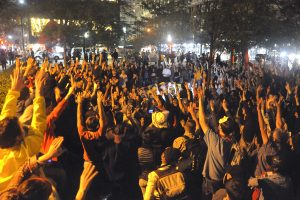
GL: How do you look at the heroic movement in Hong Kong (2019-2020), or the mass protests in Belarus, not to mention the wave of protests in France, from the yellow vests to the recent massive protests against the rise of the pension age? All of them have different agendas but many can be classified as what you call ‘participatory movements’. Is this another type of popular protest in comparison to the cases that you describe that seem to have a very specific trajectory from the alter-globalization ’Seattle’ movement to OWS to today?
MH: I call ‘participatory movements’ ones in which the organization and movement are conflated. People self-organize and participate in shaping the goals and meaning of actions, rather than being led by a vanguard organization or political party. These ways of operating are consistent with anarchist and autonomist politics. However, not everyone who participates in these participatory movements adheres to ideological labels. I am building on the work of Raul Zibechi, who uses the term ‘societies in movement’ to describe self-organization, horizontality, and autonomy. I argue that societies are moving, but they’re moving through social media. As a result, we are seeing participatory movements.
I consider the umbrella Hong Kong movement, the Belarus movement, and the Yellow Vests to be participatory movements, yes, because they exhibit similar organizational forms. In Hong Kong, what began as a more traditional pro-democracy movement became increasingly radicalized, and this culminated in 2019-2020. A younger generation worked in decentralized networks. They moved “like water” through the streets and openly confronted the police. Decisions were made in small groups and shared through Telegram channels. Participants learned from movements in other places, and one another in real time. In Belarus, there was a similar situation in which the more established organizations and institutions of the opposition were not able to fully respond to the moment. In this vacuum, spontaneous actions became more popular. There were neighbourhood assemblies that coordinated mutual aid projects, as well as blockades. I had the opportunity to personally witness the Yellow Vests, and again participants took direct actions such as blocking roundabouts or breaking police precincts. These were not coordinated by one organization. Neighbourhood and regional assemblies, which had been established during Nuit Debout were active and influential in the movement.
GL: OWS refused to formulate demands. Is this a thing of the past or was this precisely its strength? Here in NL, Extinction Rebellion which occupies highways and has very similar organizational principles as OWS, has a concrete demand (’stop fossil subsidies’). Would it be better for them to drop this?
MH: Since the 1970s, social movement theory has been dominated by politics of contention. There are of course different schools of thought, in the U.S., Europe, and elsewhere. There have been cultural interventions. However, the basic premise of contention has not changed. For collective action to take place, there must be contention and a process of claim-making. This often takes the form of a demand from a corporation or government. Contention always had limits, but these are especially obvious now.
Demands recognize the legitimacy of economic and political structures. The immediate goal of demands is to win concessions from them, and the long-term goal is to take them over. If the structures themselves are the problem, and cannot be reformed or remade, then there is no reason to make demands. In fact, it becomes very rational and strategic not to make demands. In the refusal to make demands, there is a de-legitimizing of the structures themselves, and conversely a legitimizing of alternatives to them.
Not making demands is consistent with an anti-statist position but is also just practical given the current context. Anarchists and autonomists, who see the state as fundamentally flawed, have long argued against indirect actions like making demands and in favour of direct actions. Now, we are living through the death throes of neo-liberalism, and consent for the state is fading. Some have referred to this as a “crisis of democracy.” Whether you believe that the state is always in crisis, or is just now arriving at a crisis, it simply does not make sense to make demands. How can one make demands of capitalists who want only to maximize profits or politicians who do not represent their constituents? Once we all start realizing that those in power do not care about people, and cannot be reasoned with, then we’ll be in a more advantageous position to fight them. I would urge Extinction Rebellion to reconsider their reliance on making demands and move toward resistance.
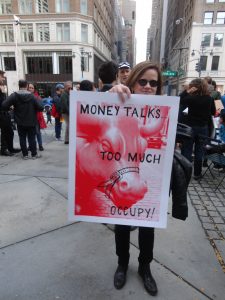
GL: How do you look at ‘Wall Street’ itself today? It seems even more virtual. An empty centre of power? And what is that like during the Covid lockdowns? There is not much about this in your book. Perhaps global finance hasn’t changed much over the past decade, except that social inequality in the US has risen even further. Is Wall Street still a central symbol? OWS was a response to the 2008 global financial crisis but so was bitcoin and the following crypto movement, in which so many young people participated. Has the public focus changed to that handful of billionaires such as Musk, Bezos and Zuckerberg (including Gates)? Occupy emphasized the centrality of space. But what space would we have to occupy today? Socialize internet infrastructure as the new public space? Where are the visible, tangible points of friction?
MH: Wall Street has become increasingly dependent on communication technology. This is the means through which transactions happen, deals are made, and data is collected. In recent years, companies such as Amazon, Apple, Google, and Meta, have moved more explicitly into the finance sector and offered their payment options. They also control the server space (physical and virtual) for other industries, and governments, to operate. Financial infrastructure is now largely controlled by the tech industry.
Cryptocurrencies, which are not only digital but operate on peer-to-peer blockchain systems, have challenged control and regulation. However, they have not addressed inequality but perpetuated it. Blockchains have been corrupted, and miners have rigged markets. These are concentrations of power, yet again, around resources, even if they’re digital. Crypto is just a de-centralized form of capitalism.
Communication technology, while virtual, is also material, which is important not to lose sight of. There are still actual wires running electricity and server farms processing code. Data collection requires enclosure and extraction of resources and uses energy. This can have devastating ecological effects. True alternatives to Wall Street will never be found built on the same infrastructure. There must be socializing from the bottom up and a different relationship to land.
OWS was a response to the global financial crisis, which banks caused. To Occupy Wall Street today would mean addressing the role of tech. It is encouraging to see tech workers organizing to challenge companies from the inside. At Amazon, Apple, Google, Meta, and other companies, there are rank and file and independent efforts to address conditions, but also the broader economy and society. At the same time, platform co-ops are re-imagining what work and relationships could look like.
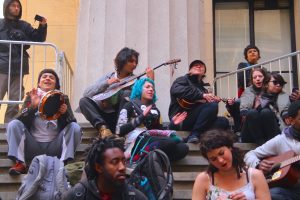
GL: You emphasize the role of consensus and argue for leaderless structures. At the same time, you describe numerous cases inside OWS of ‘informal elites’ that pop up. How can we make progress here and not regress into models of formal representation—or Leninist avant-garde strategies for that matter? There is an interesting paragraph where you mention the organizational consequences when more women are doing coordinating work.
MH: OWS was organized. It was established via an assembly model with working groups and later included many assemblies, councils, and hybrid organizational structures. The decision-making process was consensus throughout. We operated by the principle of consent rather than coercion, with the exact procedures changing depending on the participants. There was a stated embrace of direct democracy and a commitment to it in practice. It worked at scale, with hundreds and then thousands of people.
Unfortunately, our democratic experiment was thwarted in part by informal elites, that operated within and around structures and processes. They did not abide by collective decisions, or share resources, and instead consolidated power for themselves. They saw themselves as vanguards but did not lead or organize others. Instead, they demoralized and fragmented the movement.
Informal elites would claim there was no structure and no leadership that existed. This move served to justify their own attempted power grabs. It also rendered the contributions of many leaders in OWS invisible. There were leaders in OWS, but not charismatic masculine kind, speaking on behalf of others. Instead, leaders acted in service to the collective, speaking with them, and building power from the bottom up. I argue that they had a feminine leadership style. They were at times, but not always women.
GL: At the very beginning of the University of Amsterdam ‘Maagdenhuis’ occupation in the spring of 2015, overnight trainers were flown in to instruct the mostly young students and inexperienced staff on the principles of general assembly, facilitation, hand signals, mic checks to reach consensus. It all felt a bit surreal and artificial as there was nothing local or grass-roots about this mode of organization. This was the way of doing it. But it worked (so that was not the issue). Nonetheless, it had a strange Californian ‘positive’ New Age managerial feel, a processual approach aimed at banning differences and debate. In the leftist olden days, there were at least factions, wings, and tendencies (including dissents), not to mention sects and secret societies. As you know I am more in favour of smaller units, organized networks, not large caucuses. Is this especially an issue for larger movements? You describe that OWS NYC at some point had to deal with scale. Perhaps my pragmatic idea of collective decision-making only works for mid-size movements.
MH: I would wager that the “Californian” vibe during the ‘Maagdenhuis’ occupation was not the result of consensus so much as professionalization. The smoothing of differences and avoidance of conflict is consistent with the polite white liberal culture of the non-profit industrial complex. It seems that the practice of consensus, in the case you mention, was influenced by those who used it.
Consensus does not mean the absence of conflict. There will always be conflict. The question is how to navigate it. In a majoritarian system, conflict is resolved through coercion. Whoever has the most votes wins and whoever doesn’t loses. The losers are still compelled to go along with the decision made. In contrast, consensus resolves conflict through collaboration and dissension. Those affected by an issue weigh in on it and build from one another’s suggestions. The decision is the result of collective intelligence and is often more complex than the initial proposal. If there are still those who disagree with the outcome, then they can dissent. They don’t have to go along with the decision. Instead, they choose not the participate or leave the group.
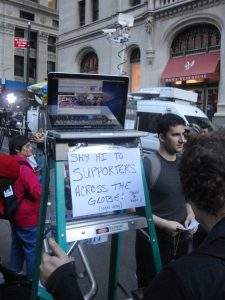
GL: A really valuable part of your ‘practice’ report is the part in which you describe how to deal with ‘disruptions’. You distinguish different types that aim to undermine social movements. These days many encounter such types online as trolls. In the public debate, this issue is then delegated to Silicon Valley which should employ more moderators and then delete their accounts (which they do and don’t). Your wisdom here is even more needed now. What’s to be done? How can we act more decisively in such cases?
MH: Again, the boundary of the digital and physical is porous. Disruptors and trolls are the same. The in-person disruptors of assemblies and councils also had online personas. Trolls, at times, leave the comfort of their lairs and venture out into the open. Regardless of the space or spaces they inhabit, these disruptors/trolls are likely lonely, misunderstood individuals looking to be heard. However, this doesn’t mean everyone must hear them. They can derail conversations and actions. Making space for them means there isn’t space for others. This may be open, but certainly isn’t democratic, or equitable. Some of these disruptors/trolls also cause harm to others either in their hateful speech or targeted actions. For all these reasons, it is vital to not feed the disruptors/trolls.
The central concern here is accountability. What behaviours are acceptable to be part of space? Which are not? What happens when a behaviour is not acceptable according to others in the space? These are essential questions for in-person and digital spaces. The answers determine who is included or excluded. Boundaries must be established through a democratic process. If a collective doesn’t agree to them, then there can be no hope of maintaining them without the use of force. Regulation of speech must not be left to Silicon Valley or the government, but to the people who are part of platforms. Rather than terms of service or oversight committees, the users of platforms must set agreements about how they wish to engage with one another.
GL: You describe an incident among coordinators of Strike Debt, of which some were people of colour, condemned the use of the consensus process and termed it racist. This was a shocking moment for you. Can you elaborate on why it was presumed racist, and how you look at this, a decade later, also in light of today’s cancel culture?
MH: The coordinators in Strike Debt had long been proponents of consensus themselves. They helped create the process we used early on in OWS. Thus, I was shocked that they suddenly called this process racist. What I understood at the time, and even more so with reflection, was that the coordinators just wanted to take power. Labelling consensus racist was a way to render the process socially and culturally unacceptable. Consensus was a stand-in for prefigurative politics more generally. Thus, doing away with consensus, meant doing away with prefiguration. This paved the way for a shift toward hierarchies.
Consensus, as a principle, and practice, is rooted in indigenous communities. It is not racist, or part of a white supremacist power structure. At first, this history didn’t seem to matter, because some BIPOC folks decided consensus was racist. White people, plagued with guilt, did not want to cross them. Luckily, not all BIPOC members of Strike Debt went along with the coordinators. They could not reach a consensus, ironically enough, for their move to power. Thus, they lost and left the group.
Cancel culture comes from black feminist organizing. Originally, calling someone out was a way to hold them accountable for harm done. What the coordinators did in Strike Debt was not aimed at addressing harm or healing. It was not about undoing dominant power dynamics. It was, in fact, about consolidating power. This is the exact opposite of the intent of black feminist organizing. We must be careful when and how to call someone out and point to specific problematic behaviours.
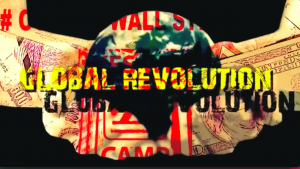
GL: In 2011-12 there were social media but platform capitalism was not yet dominant. There was a great focus, already then, on Twitter, the use of hashtags and who owns them. There was a bit of Facebook and YouTube and a lot of live streaming. At the same time, email lists were still used for internal communication. The significance of one’s websites and hosting was still strong. Retrospectively, this was the late Web 2.0 period in which participation was key—in line with your notion of participatory movements- by and large, a period of media experiments. But not for long. Wikileaks and Snowden do not play a role in your story. How would you like to see a media working group operate today? All autonomous movements are in the firm hands of Silicon Valley. There is no alternative anymore, and today’s activists seem to have given up. All organization and outreach is happening inside the mainstream platforms. What do you make of this?
MH: The period of 2011-12 was one of technological transition. Social media was relatively new, and a Web 2.0 culture was just starting to develop in which users were encouraged to share content. Platforms such as Facebook and Twitter offered those with very few technical skills a way to distribute their content. This was always a capitalist endeavour, with the immediate goal being to build out a consumer base. Once that was achieved, platforms monetized the social connections of their users. The pressure to build advertising revenue and satisfy investors became even more intense once companies became publicly traded. There were also more collaborations with government regulators and security agencies resulting in shadow banning of accounts. The ease of participation on social media platforms came at a cost, which was personal privacy, security, and stability.
There is always an alternative If we decide to make one. In 2011-2012 Wikileaks and Anonymous were very active, obviously, in pushing for a free and open internet. They used Internet Relay Chats to coordinate. While these networks experienced intense co-optation and repression, some participants were able to continue working. They also inspired subsequent generations of media and tech activists. Recently, we’ve seen the development of Mastadon and Bluesky. Non-corporate, open-source social media platforms are more autonomous than corporate social media platforms. Since the dismantling of Twitter and rebranding as ‘X’ users have jumped over to these alternative platforms, so they’re actually growing. The hold of Silicon Valley was not and is not total. I argue that participatory movements, to be truly participatory, and to protect themselves from repression, must embrace alternative social media.
Marisa Holmes, Organizing Occupy Wall Street, This is Just Practice, Palgrave Macmillan, 2023. Order here. A review by Maia Ramnath can be found here.


